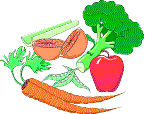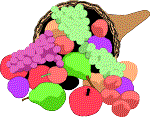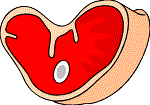
How to Dry Fruits and Vegetables

Food dehydration is safe because water is removed from the food. Because water is removed from the food, mold and bacteria cannot grow on it;thus it will not spoil. There is, however, a loss of vitamin A and C in dried foods due to heat and air. It usually takes vegetables 6-16 hours to dry, and fruit 12-48 hours. One can dry fruit and vegetables, and make jerky and fruit leather.
When drying food, don't keep temperatures too low or too high. Temperatures too low may result in the groth of bacteria on the food. Temperatures too high will result in the food being cooked instead of dried. Food that is underdried will spoil, and food that is overdried will lose its flavor and nutritive value.
Food should be dehydrated between 120 and 140 degrees Fahrenheit. You can begin drying your food at higher temperatures, but turn the temperature down after the first hour or so. The last hour or so of drying time should be turned down on a lower setting. You must turn the food and rotate the trays while the food is drying.
You will know your food is dried when when you touch it, and it is leathery with no pockets of moisture. If you are testing fruit, you can tear a piece in half. If you see moisture beads along the tear, it is not dry enough. Meat should be tough, but shouldn't snap apart. Vegetables should also be tough but can also be crisp.
When storing your dried product, keep in mind that no moisture should be allowed to enter the container...ever. Dried food absorbs moisture from the air, so the storage container must be airtight. Some acceptable storage containers are jars and plastic freezer bags. If storing fruit leather, wrap in plastic wrap and store in a another airtight container. Store your containers of dried food in a cool, dark, dry place. 60 degrees Fahrenheit or below is best.


All fruit should be washed,pitted and sliced. Arrange in single layers on trays. Dry fruit at 135 degrees Fahrenheit. You may wish to pretreat your fruit with lemon juice or ascorbic acid or it won't darken while you are preparing it for drying. Just slice the fruit into the solution and soak for 5 minutes.
To make fruit leather, puree your fruit. Apples, pears, peaches, and nectarines should be cooked before pureeing. Pour the fruit puree about 1/4-inch deep on special fruit leather drying sheets, or drying trays that have been lined with plastic wrap. Since the center does not dry as quickly as the edges, Only pour the puree 1/8-inch deep towards the center.Dry at 135 degrees Fahrenheit until pliable and leathery. The center should also be dry and have no wet or sticky spots.

Meats should be dried at 145-150 degrees Fahrenheit. Jerky should dry between 6-20 hours until pliable. It shoud not be brittle. Wipe fat off of the jerky while it is drying. Jerky does not store as long as fruits and vegetables. For long term storage longer than a month, store in the freezer or refrigerator. To aid in the curing of jerky, meat must be marinaded in salt and spices. The pioneers used 1 1/2 cups pickling salt to 1 gallon of water and soaked the meat strips in this for a couple of days. As an alternative to soaking, they also rubbed the meat with salt and spices (like garlic and pepper) before drying. You may want to use one of the following marinade recipes instead. Marinade the meat strips overnight.


3 1/2 C. dried apples
2 C. water
3/4 C. sugar
1 t. cinnamon
Cook apples until tender. The apples wil rehydrate during the cooking and baking process. Add sugar and cinnamon. Fill and top with pie crust and bake 30 minutes at 350 degrees.
Cover cherries with water and let soak for 30 minutes. Simmer and add sugar and flour to thicken. Pour into pie crust and add top crust. Bake at 400 degrees for about 35 minutes.
3 C. dried peaches
3 C. boiling water
2/3 C. flour
1 C. sugar
2 t. cinnamon
1/4 t. nutmeg
Cover fruit with water and let soak for 30 minutes. Simmer and add sugar, spices and flour to thicken. Pour into pie crust, dot with butter, and cover with pie top. Bake at 400 degress for 30 minutes.
1 C. dried corn
4 C. boiling water
2 t. sugar
1/2 C. milk
1 T. flour
1 T. margarine
salt and pepper to taste
Add corn to water and let stand for 30 minutes. Simmer corn until tender. This may take as long as an hour or so. Drain and add remaining ingredients. Simmer for an additional 5 minutes, stirring frequently to prevent scorching.
2 C. boiling water
1 C. dried beans
1 can cream of mushroom soup
Add beans to water and cook until tender. Add soup and simmer.
1 t. Dried Tomato powder
!/2 C. boiling water
1 T. flour
1/2 C. milk
To make tomato powder, blend dried tomatoes in food processor. Add powder to water and simmer. Add flour to milk and stir. Add flour/milk mixture to water and tomatoes. Simmer and stir to prevent scorching.
3 C. dried fruit of your choice
2 C. boiling water
1 t. cinnamon
Sugar to taste
Let fruit soak in the boiled water for 20 minutes. Simmer for another 20 minutes and add cinnamon and sugar. Stir until sugar is dissolved and serve.
Cover dried vegetables with boiling water and soak 1 hour, then simmer for 2 hours or until tender. Remember you can add fresh vegetables, in case you don't have a particular dried one, to the pot as well.






Introduction on Canning Fruits and VegetablesPage 1 of "How to Can and Freeze Fruits and Vegetables from Your Garden." This page talks about what you should know before you begin to can.
How to Can Vegetables Using a Pressure CannerPage 2 of "How to Can and Freeze Fruits and Vegetables from Your Garden." This talks about canning vegetables using a pressure canner.
How to Can Vegetables Using a Boiling Water CannerPage 3 of "How to Can and Freeze Fruits and Vegetables from Your Garden. This page talks about canning vegetables using a boiling water canner.
How to Can FruitPage 4 of "How to Can Fruits and Vegetables from Your Garden." This page talks about canning fruit.
How to Freeze Fruits and Vegetables from Your Garden.Page 5 of "How to Can and Freeze Fruits and Vegetables from Your Garden." This page talks about freezing basics and "how-to's."
How to Make Jams and Jellies Page 6 of "How to Can and Freeze Fruits and Vegetables from Your Garden." This page talks about the tips and tricks of making homemade jams and jellies.
How to Make Pickles and RelishPage 7 of "How to Can and Freeze Fruits and Vegetables from Your Garden." This page talks about pickling.
How to Dehydrate Fruits and Vegetables from Your Garden.Page 8 of "How to Can and Freeze Fruits and Vegetabes from Your Garden." This page talks about drying and lists dtying times for fruits and vegetables.
How to Make lye Soap and Other Homemade Concoctions Page 9 of "How to Can and Freeze Fruits and Vegetables from Your Garden." This page talks about making lye soap and other old-fashioned, homemade concoctions and remedies.
Home Processing Troubleshooting GuidePage 10 of "How to Can and Freeze Fruits and Vegetables from Your Garden." This page answers your questions about canning and freezing garden produce.
Other Home Canning Links This site lists other links that you may find helpful.